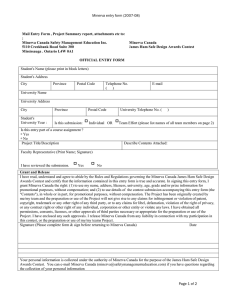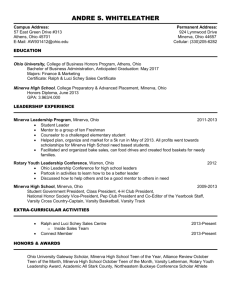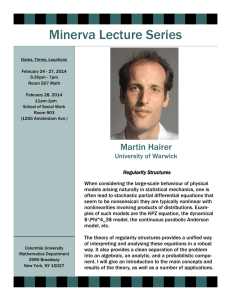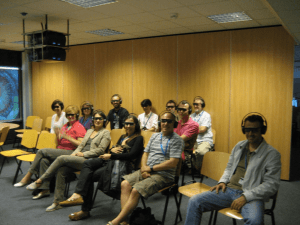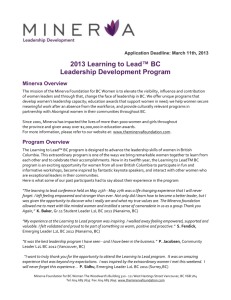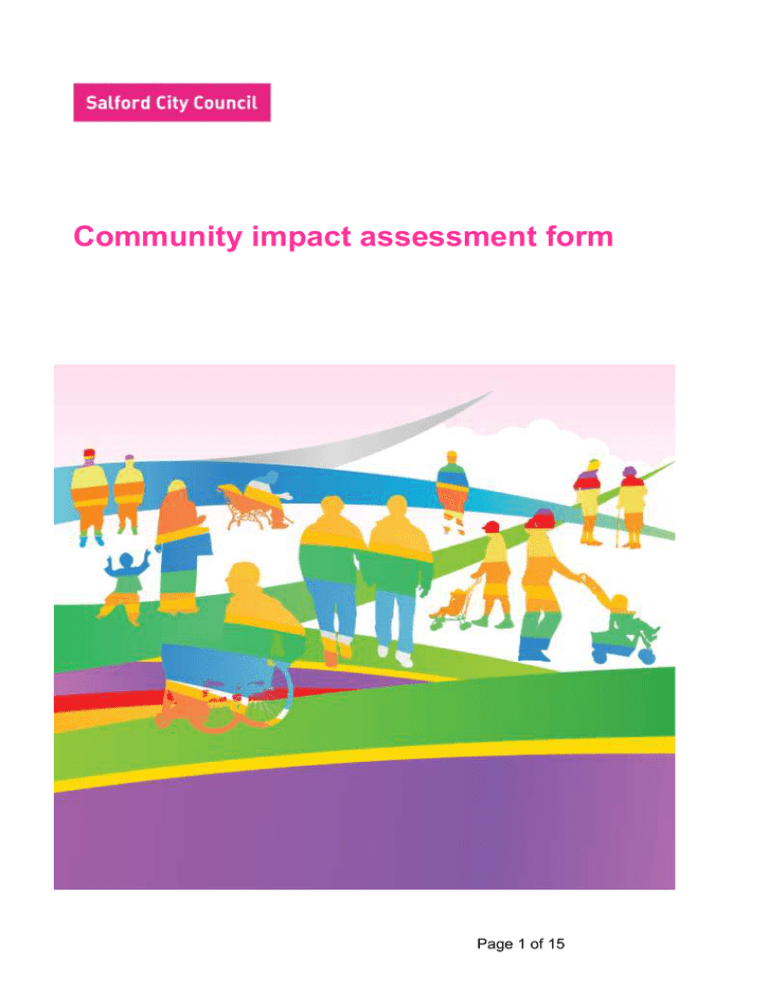
Community impact assessment form
Page 1 of 15
Community impact assessment screening process
Person(s) responsible for the assessment
(Please note that it is advisable that you undertake your community impact assessment
in a group)
Rebecca Hornby, Alan Cowper, Paul Budis
Directorate
Children's Services
Name of function to be assessed (this can be a policy, procedure, strategy or service)
The closure of Minerva House reception as part of the implementation of the corporate strategy
of providing face-to-face customer service at dedicated customer service environments such as
Unity House and the Gateway Centres.
Date of assessment Jan 2010
Is this a function that is new
1. Please provide a brief description of the function or the proposed change to the
function
Minerva House will cease operating as a customer facing outlet and all face to face customer
service will be re-engineered to be delivered at different locations (such as Unity House and
the 3 Gateway Centres) or by different channels (such as on the internet, by Telly Talk) or by
being delivered directly by Customer Services personnel (tier 1 and tier 2 activities only). All
face to face services currently delivered will still be available to customers, but not at Minerva
House.
Professional visits will continue to the building and will be facilitated through the use of visitor
management technology and new protocols widening colleagues ability to access the building.
2. What are the aims of the service, strategy, policy or procedure?
It is important to get this right as they will be the focus of the impact assessment
To implement the corporate customer service strategy of consolidating customer
service within dedicated customer service environments.
The objective of this strategy is make services more accessible and convenient for
customers by enabling a wider range of services to be available at each of these
dedicated facilities .
3. If you are considering a strategy or service, please list any related policies
Corporate Customer Service Strategy
Think Efficiency Implementation
Page 2 of 15
4. Please list any group who has an interest in or who will benefit from the function (this
can include service users, stakeholders, beneficiaries).
All Service users of teams based at Minerva House.
Teams based at Minerva House.
Colleagues and Peers who frequently visit Minerva House.
5. Please list any aspects of your service or policy which are delivered externally or with
external partners.
N/K
6. Is there any evidence of higher or lower participation or uptake by different groups?
Socio-economic
yes
Race
Age
don't know
Disability
yes
Gender
don't know
don't know
Religion and/ or belief
Sexual identity
don't know
don't know
No information available for most categories. Only action that could be taken was to
examine the visitor’s book (which was analysed but revealed only that the majority of
visits were by colleagues and professional peers.)
No team when questioned about customers provided any specific examples of face to
face contact being of higher or lower volume for any of the above groups apart from:
-Locality teams reported that penalty fine payments were usually paid in cash at the
counter by socio-economic groups from lower financial brackets (whereas more affluent
families tended to not visit for this purpose but instead send a cheque by post)
- Special Educational Needs -clearly used more by families where a child has an
additional or special need of some kind.
Page 3 of 15
7. Is there any evidence that different groups have different needs, experiences, issues
and priorities in relation to this function?
Socio-economic
don't know
Race
don't know
Age
don't know
Religion and/ or belief
don't know
Disability
don't know
Sexual identity
don't know
Gender
don't know
This information is not available.
8. Is there an opportunity to better promote equality and diversity or better community
relations for the following groups, by working with others? e.g. partners, community and
voluntary groups
Socio-economic
don't know
Race
don't know
Age
don't know
Religion and/ or belief
don't know
Disability
don't know
Sexual identity
don't know
Gender
don't know
As 7. without the base data of knowing who visits the building it would be impossible to
assess.
9. Have consultations with relevant groups, organisations or individuals indicated that
this policy creates problems that are specific to them?
Socio-economic
don't know
Race
don't know
Age
don't know
Religion and/ or belief
don't know
Disability
don't know
Sexual identity
don't know
Gender
don't know
As 7.
We questioned the reception area staff (as advocates for all groups of visitors) as to
whether any specific assistance is currently offered to any visitors. Assistance is
offered only to a client when requested and reception staff report that this is currently a
rare event.
Page 4 of 15
If you have answered ‘yes’ to the last four sections you will need to complete the rest of
the form, If you have answered ‘no’ to them please complete the next box and return to
your directorate equality lead officer.
Comments: Please assess the supporting evidence provided particularly the summary
document detailing the aims and objectives of this project and the methodology
employed.
Although no consultation exercise with service users has been conducted this is on the
basis that preliminary analysis identified visitors to this building as being mainly
colleagues professional peers rather than service users. Furthermore it is suggested
that the change being proposed is actually intended to provide more convenient access
to Children’s Services for all groups.
Date sent to directorate equality lead officer Jan 15 2010
Screening received and reviewed by directorate equality lead officer
Name
Date
Signed
Page 5 of 15
Full community impact assessment
Narrowing the gap – socio-economic inequality
Please consider the following areas… poverty, health, well-being, access to services,
housing, employment.
1. How does the service ‘narrow the gap’ and reduce the extent to which outcomes are
dependent on income?
Currently only a small proportion of the population of Salford live within easy walking
distance of Minerva House and most would have to travel by bus or car to access
services. By enabling the services to be accessible in at least 4 outlets across the city
we will be narrowing the gap by making it cheaper and faster for all sectors to access
services.
2. Please list any barriers which may prevent people from low income backgrounds from
achieving positive outcomes from the function
Only a small proportion of Swinton residents who can currently access Minerva House
by walking will only have to travel a very small additional distance to access the service
at Unity House. This is vastly outweighed by the convenience for customers living in the
Walkden, Eccles and Pendleton areas of the city who will now be able to access services
at their neighbourhood Gateway Centres.
There are some visitors who attend Minerva House to make direct payments in cash for
truancy and attendance fines. In future, cash payments will not be accepted at Minerva
House and cash is not accepted at other Council Buildings. Alternative arrangements
are being made to enable parents to make payments via Sundry Debtor system and at
the Post Office.The current system is being amended to improve early contact with
parents when they receive the fine to enable discussion about family circumstances.
Access to other appropriate services will also be available at Unity House and Gateway
Centres.
3. Please detail how these barriers may be overcome.
N/A – see above
4. Please list any baseline income data and analysis which indicate that deprivation
issues are relevant to your function
As per question 7 of screening section – no data identified which indicates the
economic background of clients visiting Minerva House. No data was referenced in
consultations with senior team members.
Page 6 of 15
5. Please provide evidence of how services are targeted or designed based on our
knowledge of need and deprivation
As per question 1.
If your policy is relevant to narrowing the gap, please continue to complete this section.
6. Please list any data or evidence you have which demonstrates access of service and
benefits
Currently low numbers of client visitors have been identified through analysis of visitors
books and estimates of clients’ visits by team representatives. Unity House and
Gateways record extremely high volumes of client visits and have been designed to be
easily accessed by public transport and to meet at required DDA standards. By reengineering the face to face contact from one location some distance from public
transport routes to multiple locations more easily accessible we will demonstrably
improve the access to Children’s Services for clients.
7. Does this data show that any groups access the service more/less?
No data identified.
8. Does this data show any better or worse outcomes are achieved from the service for
different income groups?
No data identified.
9. Can any unfavourable impacts be justified?
No unfavourable impact on socio-economically deprived groups can be identified by
implementing this policy. Impact appears to be mainly favourable. However, please see
previous comments about parents who attend Minerva House to pay fines.
Age
Please consider the following areas… younger people, middle-aged people, olderpeople, access issues, communication, transport, engagement.
please note: this is not an exhaustive list
1. Please list any barriers which may prevent people from achieving positive outcomes
from the service as a result of their age
None identified – even the small proportion of Swinton residents who can currently
access Minerva House by walking will only have to travel a very small additional
distance to access the service at Unity House. This is vastly outweighed by the
convenience for customers living in the Walkden, Eccles and Pendleton areas of the city
who will now be able to access services at their neighbourhood Gateway Centres. This
may be more relevant to older people especially those with more limited mobility.
2. Please detail how these barriers may be overcome.
N/A
Page 7 of 15
3. Please list any baseline data or evidence you have e.g. census data
As per question 7 of screening section – no data identified which indicates the age of
clients visiting Minerva House. No data was referenced in consultations with senior
team members.
4. Please list any data or evidence you have which demonstrates service users
accessing the service
Analysis of Visitor Book – no ability to identify age of visitor though.
5. Does this data show that any groups access the service more/less?
See 4.
6. Does this data show any better or worse outcomes are achieved from the service for
this group?
See 4.
7. Can any unfavourable impact be justified?
Impact appears to be favourable. Please see comments re parents paying fines.
Disability
Please consider the following areas… access - venues information, communication
tools, promoting services, transport, health and well-being, engagement, hate crime.
1. Please list any barriers that service users may encounter when accessing services
Minerva House is not particularly easy to access. The transfer of face to face customer
service to the Gateways and unity House should improve accessibility for this group.
2. Please list any barriers which may prevent people with disabilities from achieving
positive outcomes from the service.
None identified – even the small proportion of Swinton residents who can currently
access Minerva House by walking will only have to travel a very small additional
distance to access the service at Unity House. This is vastly outweighed by the
convenience for customers living in the Walkden, Eccles and Pendleton areas of the city
who will now be able to access services at their neighbourhood Gateway Centres. This
may be more relevant to those with more limited mobility.
3. Please detail how these barriers may be overcome.
N/A
4. Please list any baseline data or evidence you have e.g. census data
As per question 7 of screening section – no data identified which indicates the disability
status of clients visiting Minerva House. No data was referenced in consultations with
senior team members.
5. Please list any data or evidence you have which demonstrates service users
accessing the service
Analysis of Visitor Book – no ability to identify age of visitor though.
Page 8 of 15
6. Does this data show that any groups access the service more/less?
See 5.
7. Does this data show any better or worse outcomes are achieved from the service for
this group?
See 5.
8. Can any unfavourable impact be justified?
None identified. Impact appears to be favourable. Transfer of service to Gateways in particular
enables health and social services to be delivered at the same location to the convenience of
clients in this group.
Gender
Please consider men, women, transgender maternity and pregnancy,
marriage and partnerships, data monitoring, engagements
1. Please list any barriers that service users may encounter when accessing services
Minerva House is not particularly easy to access but it is difficult to assess how
this might affect these groups more than others.
2. Please list any barriers which may prevent people from achieving positive outcomes
from the service as a result of their gender
Minerva House is not particularly easy to access but it is difficult to assess how
this might affect this group more than others.
3. Please detail how these barriers may be overcome.
N/A
4. Please list any baseline data or evidence you have e.g. census data
As per question 7 of screening section – no data identified which indicates the
gender of clients visiting Minerva House. No data was referenced in consultations with
senior team members.
5. Please list any data or evidence you have which demonstrates service users
accessing the service
see 4.
6. Does this data show that any groups access the service more/less?
see 4.
7. Does this data show any better or worse outcomes are achieved from the service for
this group?
see 4.
8. Can any unfavourable impact be justified?
None identified.
Race
Page 9 of 15
Please consider the following areas…minority ethnic groups, interpretation translation,
cultural consideration
1. Please list any barriers that service users may encounter when accessing services
Minerva House is not particularly easy to access but it is difficult to assess how
this might affect this group more than others.
2. Please list any barriers which may prevent people from achieving positive outcomes
from the service as a result of their race
None identified – even the small proportion of Swinton residents who can
currently access Minerva House by walking will only have to travel a very small
additional distance to access the service at Unity House. This is vastly outweighed by
the convenience for customers living in the Walkden, Eccles and Pendleton areas of the
city who will now be able to access services at their neighbourhood Gateway Centres.
There may be difficulties for this group in accessing information face to face regardless
of location,
3. Please detail how these barriers may be overcome.
Customer Service staff at all Gateways and Unity House are experienced in
assisting customers where English is not the first language.
4. Please list any baseline data or evidence you have e.g. census data
As per question 7 of screening section – no data identified which indicates the race of
clients visiting Minerva House. No data was referenced in consultations with senior
team members.
5. Please list any data or evidence you have which demonstrates service users
accessing the service
see 4.
6. Does this data show that any groups access the service more/less?
see 4.
7. Does this data show any better or worse outcomes are achieved from the service for
this group?
see 4.
8. Can any unfavourable impact be justified?
None identified.
Religion and/or belief
Please consider the following areas… all religious communities,
consideration of faith calendars, religious festivals, religious needs,
Page 10 of 15
1. Please list any barriers that service users may encounter when accessing services
None identified beyond location of Minerva House inconvenient for all groups beyond
immediate vicinity.
2. Please list any barriers which may prevent people from achieving positive outcomes
from the service as a result of their religion and or belief
None identified.
3. Please detail how these barriers may be overcome.
N/A
4. Please list any baseline data or evidence you have e.g. census data
As per question 7 of screening section – no data identified which indicates the
race or faith of clients visiting Minerva House. No data was referenced in consultations
with senior team members.
5. Please list any data or evidence you have which demonstrates service users
accessing the service
see 4.
6. Does this data show that any groups access the service more/less?
see 4.
7. Does this data show any better or worse outcomes are achieved from the service for
this group?
see 4.
8. Can any unfavourable impact be justified?
None identified.
Sexual identity
Please consider the following areas… gay men, lesbians, bisexual people, hate crime,
civil partnerships
1. Please list any barriers that service users may encounter when accessing services
None identified beyond location of Minerva House inconvenient for all groups
beyond immediate vicinity.
2. Please list any barriers which may prevent people from achieving positive outcomes
from the service as a result of their sexual identity
None identified.
3. Please detail how these barriers may be overcome.
N/A
4. Please list any baseline data or evidence you have e.g. census data
Page 11 of 15
5. Please list any data or evidence you have which demonstrates service users
accessing the service
As per question 7 of screening section – no data identified which indicates the
sexual identity of clients visiting Minerva House. No data was referenced in
consultations with senior team members.
6. Does this data show that any groups access the service more/less?
see 5.
7. Does this data show any better or worse outcomes are achieved from the service for
this group?
see 5.
8. Can any unfavourable impact be justified?
None identified.
Community cohesion
Please consider the following areas…
people from different backgrounds getting on well , understanding between
communities, developing a sense of belonging
1. Does the function promote/support community cohesion?
Gateway centres are used by many community groups and are a focus for community
engagement. Transfer of face to face service from one location at Minerva House to the
Gateways is definitely bringing services more into the community and making them more
visible.
2. If community cohesion is relevant to your function what steps will you take to
promote it?
Page 12 of 15
Consultation – planning
Who are the groups, organisations and individual most likely to be affected by the proposed policy, directly and
indirectly?
All Service users of Children’s Services particularly families.
Officers located at Minerva House.
Colleagues visiting Minerva House.
What methods of consultation are most likely to succeed in attracting the organisations and people you want to reach?
Unsure.
Has there been any recent research or consultation with the group/individuals you plan to consult? (please give details)
Not Known,
Consultation- results
When did you undertake the consultation?
Did you reach all the groups/individuals you wanted to reach?
What did you find?
What will you change as a result of the consultation? Please ensure this is captured in the action plan
Page 13 of 15
Action plan (following consultation)
Please list issues identified from targeted consultation and actions required
Issue identified
Action required
Person responsible
Date required by Outcome
Please ensure you have provided as much evidence as possible to support the responses you have given
Additional comments
Monitoring
How and when will the action plan be monitored?
How and when will outcomes be recorded?
Who will the results of the impact assessment be shared with?
Have the actions been mainstreamed into the service plan?
Page 14 of 15
Quality assurance
When you have completed your impact assessment, it must be submitted to your directorate quality assurance panel for
approval.
Signed
Dated
(Completing officers)
Dated
Signed
Dated
(Lead officer)
Signed
Dated
(Quality assurance panel)
Dated
Dated
Dated
This impact assessment must be reviewed every three years.
Review date:
Please send your approved impact assessment and narrative to elaine.barber@salford.gov.uk, for publishing on the
council’s website.
Page 15 of 15


